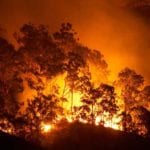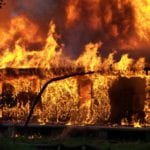COMMENTARY
Numerous articles have boldly declared Pacific Gas and Electric (PG&E) to be the first of many climate change-related bankruptcies to come. The authors wag their fingers in caution at corporations across the globe, calling for them to focus more acutely on climate-related risks. They note the significant and attendant liabilities associated with such risks, saying those risks will increase with each passing year that dramatic climate solutions are not implemented.
Most of these articles seem premised on the idea that these risks are somehow catching businesses by surprise. Accordingly, finding that PG&E was suddenly and catastrophically overwhelmed by climate change-related wildfires plays into such a narrative. The reality is that this narrative is an unfortunate and drastic oversimplification of the unique circumstances that have forced California’s largest utility into bankruptcy.
Wildfire Risk Was Not a Surprise
The wildfire risks and liabilities that are challenging PG&E, and that have mushroomed in recent years, are not a surprise. The California Public Utilities Commission (CPUC) opened a rulemaking in November 2008 on fire safety to “consider revising and clarifying the Commission’s regulations designed to protect the public from potential hazards, including fires, which may be caused from electric utility transmission or distribution lines… ”

PG&E, other investor-owned utilities, and stakeholders from across California, including the California Department of Forestry and Fire Protection (CAL FIRE), actively participated in more than 50 technical workshops focused on all aspects of fire safety over the years. These collaborative initiatives resulted in the creation of utility infrastructure-specific fire maps, specialized safety regulations for high fire areas, and fire emergency plans. That was not enough to prevent the deadly and tragic wildfires that swept through PG&E’s service territory in the past few years.
Application of Inverse Condemnation to Public Utilities
Inverse condemnation as a concept is not unique to California. Government agencies that cause damage to private property while providing a public service results in inverse condemnation in many states. However, California courts have ruled that the doctrine extends to public utilities in the state, because they too are authorized by California to provide a vital public service.
Particularly problematic for PG&E and the other California investor-owned utilities is the fact that the inverse condemnation doctrine stems from the state’s constitution. The big legal question looms as to whether the California legislature can unilaterally revise the inverse condemnation doctrine without a constitutional amendment.
State lawmakers and California Gov. Gavin Newsom are so far seemingly undeterred by this fundamental legal question. However, it is absolutely clear that the California courts will be called on to settle ongoing questions as to the applicability of inverse condemnation on public utilities no matter what solutions are ultimately put forth. And until then, California utilities, and PG&E in particular, will continue to be held liable for damages from fires sparked by their electric equipment even when the utilities do actually follow all of California’s increasingly stringent safety requirements.
PG&E’s Track Record Must Be Considered
PG&E failures with respect to vegetation management have been documented for years. These were discussed well before climate change-related drought conditions decimated the brush lands and forests in Northern California, which created tinderbox conditions during peak Santa Ana wind seasons.
As far back as 1999, and after a year-long investigation into PG&E’s vegetation management practices from 1994 through 1998, PG&E was accused of violating the law by not meeting tree-line clearance and vegetation control requirements, and by not properly recording expenditures associated with these requirements. PG&E ultimately settled with the CPUC’s enforcement staff, but the investigation highlighted many of the same issues with PG&E’s management of wildfire risk that have continued to this day.
And then there is the 2010 San Bruno, California, natural gas pipeline explosion and its aftermath. Many of the current accusations levied at PG&E with respect to its maintenance and replacement of the transmission and distribution lines that allegedly caused some of the wildfires are strongly reminiscent of the reasons for PG&E’s criminal conviction in the San Bruno tragedy, which left eight people dead and dozens injured.
Further, Judge William Alsup of the U.S. District Court for the Northern District of California already found that PG&E has violated the terms of its probation following its criminal conviction as a result of the San Bruno incident—even before any formal criminal charges have been filed against PG&E associated with the wildfires.
Accordingly, PG&E’s bankruptcy is likely more the product of its unique circumstances rather than climate change being its singular cause. This does not somehow negate the need for companies to focus on climate change-related risks, nor is this suggesting that climate change is not a real and existential threat to both business and humanity at large. Instead, we should all be careful not to fall prey to any narrative that leads us to conclude that a business that fails to properly manage its climate change-related risks is in any way a “victim” of climate change. ■
—Vidhya Prabhakaran is a San Francisco-based partner at Davis Wright Tremaine LLP, where he chairs the firm’s energy group.










